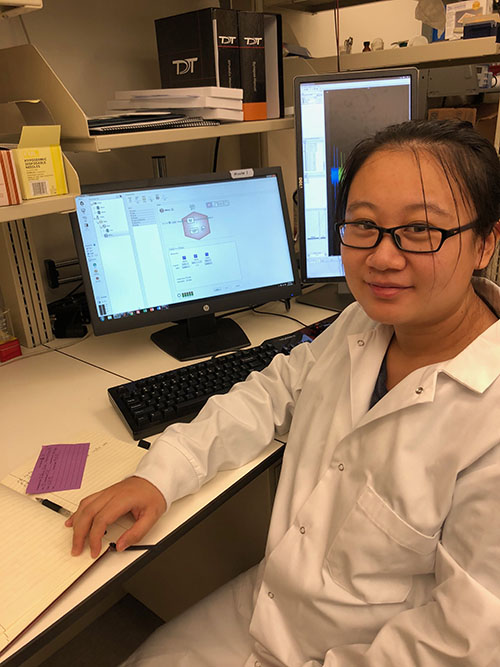Set aside the old platitude suggesting "the way to the heart is through the stomach." The distinctive, interdisciplinary work being done by PhD candidate Jiayue (Cherry) Cao and a world-class team of mentors and collaborators at the Purdue College of Engineering and Indiana University School of Medicine explores a genuinely exciting field of study - what Cherry calls "the brain-gut axis." Coming to Purdue to study biomedical engineering after earning bachelor's and master's degrees in the subject at China's Zhejiang University, she is becoming a leader in using diverse tools to explore the relationships of human stomachs and brains.
"If we can stimulate some part of the brain-gut axis, we may develop a better way to help patients, such as therapy for the person suffering from gastroparesis," she says. That's a condition, possibly caused by damage to the vagus nerve emerging from the brain stem, in which the stomach does not properly digest food or empty itself. Tie-ins between an upset stomach and stress, for example, "have been seen for a long time, but this is an under-explored area." Clinicians find that chronic gastric problems can eventually contribute to depression, anxiety, and other neurological disorders, she adds.

Cherry is fascinated with neuroscience research and is developing a wide range of insights not only through biology, but through technology. Upon completing her studies in China, "I wanted to find a place that has a strong interest in neuroscience and also a strong engineering background." The Weldon School of Biomedical Engineering at Purdue was her selection because "it was a great match for me." Resources have included fellowships and a distinguished mentor team led by Zhongming Liu, who combines PhD expertise in electrical and biomedical engineering. The team also includes Terry Powley, a professor in behavioral neuroscience who is considered a leading expert on vagus nerve projection from the gut to the brain, plus Thomas Nowak, professor of clinical medicine at IU School of Medicine.
Their collaboration with Cherry, already in progress for nearly three years, is partially supported by the National Institutes of Health. It aims to develop imaging-guided stimulation of the vagus nerve for treating patients with chronic gastric disorders. Those disorders are related to a variety of health problems, including diabetes and obesity, as well as gastroparesis.
Purdue's specialized laboratories utilize three principal research tools. "One is fMRI [functional magnetic resonance imaging], which can image the neural activity in the brain," she says. "We have the abdominal MRI, which can visualize how the stomach and intestines work and push food out. And we have another tool, which is electrophysiology recording; which can record how the neural activity in the brain will respond to gastric stimulation."
Her mentor team recognizes her capabilities in research and medical practice, along with scientific and engineering know-how, which combine for the goal of clinical translation. They say she contributes through MRI instrumentation, the veterinary physiology and surgical skills which support animal testing, and the development of sophisticated data analysis.
Cherry, whose PhD studies have one more year to go, says she may choose a postdoctoral position, maintaining a long-term desire to combine research work and a professorship. But she doesn't want to lose sight of the clinical connection that is nurtured in hospitals. "The whole idea behind my biomedical research is to benefit human health."
Mentor team director Liu said the potential benefits for human health from this work go beyond any gut reaction: "Although our initial focus is on gastric disorders, the success of this project will allow the team to address many brain disorders which often accompany gastric diseases," and which could extend to mental health challenges, as well.